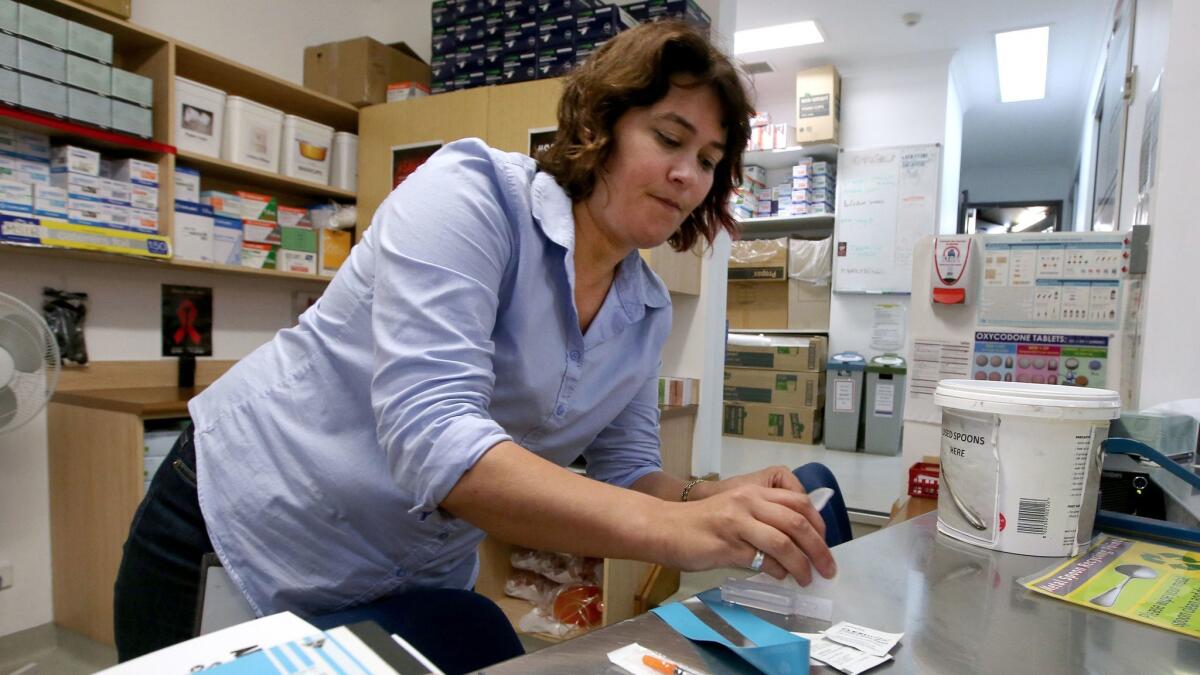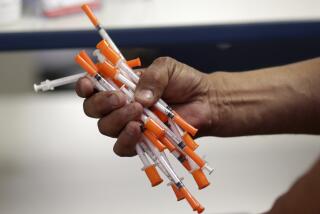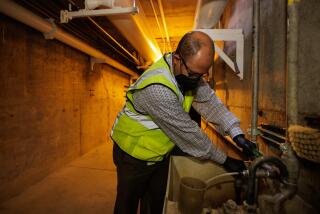Editorial: Safe injections centers are not opium dens

Government-sanctioned and supported “supervised injection centers,” where addicts can bring their illicitly obtained drugs and shoot up with little fear of arrest or a fatal overdose, have been in service in Europe for decades.
There’s only one in all of North America, though. It’s in Canada — a Vancouver, Canada, center called Insite. Research found that after the center opened in 2003 fatal drug overdoses decreased by 35% in the nearby community. Earlier this month Canadian officials authorized injection centers in Montreal, Toronto and other cities.
Unsurprisingly, this is an extremely controversial idea south of the border, where some people dismiss them as legalized shooting galleries. Just this month, Boston city officials rejected a proposal supported by the Massachusetts Medical Society and others to develop a pilot injection center program in the city’s “Methadone Mile.” Government, critics say, shouldn’t sanction the use of dangerous drugs.
The opioid addiction crisis ravaging communities from coast to coast calls not only for immediate action, but for new approaches as well.
But with drug overdose now the leading cause of accidental death in Americans under 50, it may be time to reconsider that position. The opioid addiction crisis ravaging communities from coast to coast calls not only for immediate action, but for new approaches as well. Yes, the U.S. needs to fund addiction prevention and treatment programs. But it also needs to think about what are called “harm-reduction” strategies that can help keep people who do use drugs. This is the idea behind needle exchange programs and the effort to equip police and other authorities with naloxone, a drug that reverses opioid overdoses in just minutes. It is also the idea behind safe injection sites.
A bill in Sacramento would allow eight selected counties, including Los Angeles, to try the idea out. Not only is the philosophy of safe injection centers consistent with California’s efforts to treat addiction as a disease not a crime, but a pilot project would gather invaluable data. The proposal by Assemblywoman Susan Eggman (D-Stockton) comes up for a crucial vote in a state Senate committee hearing in early July.
The bill is sponsored by the Drug Policy Alliance and supported by a wide array of addiction and AIDS prevention groups. Nevertheless, it faces an uncertain future because of strong opposition by law enforcement groups that view these centers as “government-sanctioned drug dens” (as one Republican lawmaker put it recently). Some critics also wonder whether such sites would leave local governments liable in the case of an overdose. These seem like solvable concerns that should be addressed and fixed before the legislation passes.
It’s counterintuitive to fight addiction by facilitating drug use. But injection sites, also known as fix rooms, are not opium dens of yore. In fact, they look exactly like health facilities. There’s a nurse on site to administer anti-overdose medication if needed. Last year, 1,781 overdoses were stopped at Vancouver’s Insite — overdoses that might have proved fatal had they occurred elsewhere. No one has died from an overdose at the facility.
Sterilized needles and cooking implements are available so that users don’t risk contracting HIV and other blood-borne viruses or infections from dirty needles. Staff members at the injection centers are trained to make referrals for counseling and addiction treatment. In addition to saving lives, injection centers are often the first step for many on the road to sobriety, according to the Canadian program. Indeed, of the 6,532 people who fixed at Insite in 2015, 464 were referred to a related detox facility. More than half completed the program. Though the centers make clear that treatment is available, they don’t make it a condition of using the site for fear of scaring off people coming to the centers for safety reasons.
Detractors are correct that injection centers alone can’t solve the opioid crisis — but harm reduction should certainly be part of the solution. Last year 59,000 people died from drug overdoses in the U.S., the majority of which involved opioids such as heroin and fentanyl. This year is shaping up to be even worse.
Boston notwithstanding, attitudes about injection centers appear to be changing. Earlier this month, the American Medical Assn. decided to support safe injection facilities. Washington, among the states hardest hit by drug deaths, is opening the nation’s first supervised injection center. These are hopeful signs. The United States is in the grip of a crisis and must care for people at all stages of addiction. That includes keeping alive those who are still using.
Follow the Opinion section on Twitter @latimesopinion and Facebook
More to Read
A cure for the common opinion
Get thought-provoking perspectives with our weekly newsletter.
You may occasionally receive promotional content from the Los Angeles Times.






